Digital transformation is the cultural, organizational and operational change of an organization, industry or ecosystem through a smart integration of digital technologies, processes and competencies across all levels and functions in a staged and strategic way (also see digital transformation strategy).
Digital transformation (also DX or DT) leverages technologies to create value and new services for various stakeholders (customers in the broadest possible sense), innovate and acquire the capabilities to rapidly adapt to changing circumstances.
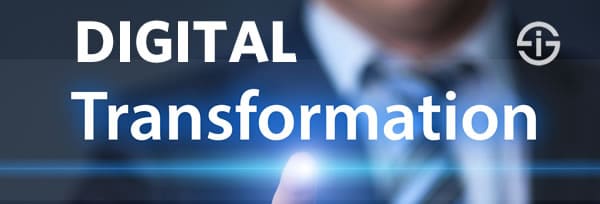
- Digital business transformation – a holistic approach
- DX and the usual suspects – beware of hype
- Digital transformation happens everywhere
- Transformation myths and realities
- Towards a DX economy
- Pro-sponsiveness and pro-daptation: focus on future and outcomes
- Digital transformation, digitization and essential elements
- Getting strategic
- The future: COVID-19, sustainability and the impact of challenges ahead
- Digital transformation and the customer experience
- Digital transformation and marketing
- Digital transformation and hyper-connected optimization
- DX and the key role of data and information
- Digital business transformation across various industries
- Digital transformation beyond technology: the human differentiator
- Digital transformation and linear management thinking
- Digital transformation – the inevitable definition discussions
While DX is predominantly used in a business context, it also impacts other organizations such as governments, public sector agencies and organizations which are involved in tackling societal challenges such as pollution and aging populations by leveraging one or more of these existing and emerging technologies.
Digital transformation is not just about disruption or technology. It’s about value, people, optimization and the capability to rapidly adapt when such is needed through an intelligent use of technologies and information.
In some countries, such as Japan, digital transformation even aims to impact all aspects of life with the country’s Society 5.0 initiative (which has some similarities with the Industry 4.0 industrial transformation vision).
Digital transformation is the profound transformation of business and organizational activities, processes, competencies and models to fully leverage the changes and opportunities of a mix of digital technologies and their accelerating impact across society in a strategic and prioritized way, with present and future shifts in mind.
The development of new competencies revolves around the capacities to be more agile, people-oriented, innovative, customer-centric, streamlined, efficient and able to induce/leverage opportunities to change the status quo and tap into big data and new, increasingly unstructured data sources – and service-driven revenues, with IoT as a vital enabler. Digital transformation efforts and strategies are often more urgent and present in markets with a high degree of commoditization.
Present and future shifts and changes, leading to the necessity of a faster deployment of a digital transformation strategy, can be induced by several causes, often at the same time, on the levels of customer behavior and expectations, new economic realities, societal shifts (e.g. aging populations), ecosystem/industry disruption and (the accelerating adoption and innovation regarding) emerging or existing digital technologies.
In practice, end-to-end customer experience optimization, operational flexibility and innovation are key drivers and goals of digital transformation, along with the development of new revenue sources and information-powered ecosystems of value, leading to business model transformations and new forms of digital processes. However, before getting there it’s key to solve internal challenges as well, among others on the level of legacy systems and disconnects in processes, whereby internal goals are inevitable for the next steps.
Digital transformation is a journey with multiple connected intermediary goals, in the end, striving towards ubiquitous optimization across processes, divisions and the business ecosystem of a hyper-connected age where building the right bridges (between front end and back office, data from ‘things’ and decisions, people, teams, technologies, various players in ecosystems etc.) in function of that journey is key to succeed.
Taking a step back and holistically looking at and questioning the many ‘digital’ changes and initiatives at several levels within various departments across the extended organization is key for digital transformation success
The human element is key in it on all levels: in the stages of transformation as such (collaboration, risk management, ecosystems, skills, culture, empowerment etc.) and obviously in the goals of digital transformation. Since people don’t want ‘digital’ for everything and do value human and face-to-face interactions there will always be an ‘offline’ element, depending on the context. Yet, also in non-digital interactions and transactions digital transformation plays a role in the sense of empowering any customer-facing agent and worker.
A DX strategy aims to create the capabilities of fully leveraging the possibilities and opportunities of new technologies and their impact faster, better and in more innovative way in the future. A digital transformation journey needs a staged approach with a clear roadmap, involving a variety of stakeholders, beyond silos and internal/external limitations. This roadmap takes into account that end goals will continue to move as digital transformation de facto is an ongoing journey, as is change and digital innovation.
In this online guide we explore the essence of digital business transformation as a vision to take this journey, its evolutions and how it is present across various business processes and industries.
Digital business transformation – a holistic approach
Digital technologies – and the ways we use them in our personal lives, work and society – have changed the face of business and will continue to do so. This has always been so but the pace at which it is happening is accelerating and faster than the pace of transformation in organizations.
Digital transformation is probably not the best term to describe the realities it covers. Some prefer to use the term digital business transformation, which is more in line with the business aspect. However, as an umbrella term, digital transformation is also used for changes in meanings that are not about business in the strict sense but about evolutions and changes in, for instance, government and society, regulations and economic conditions on top of the challenges posed by so-called disruptive newcomers. It’s clear that changes/shifts in society have an impact on organizations and can be highly disruptive as such when looking at transformations from a holistic perspective. No company, industry, economic actor/stakeholder and area of society stands on its own.
It is key to recognize the umbrella term dimension of digital transformation at all times. While digital transformation maturity models can help in defining visions they are too simplistic and/or general in practice.
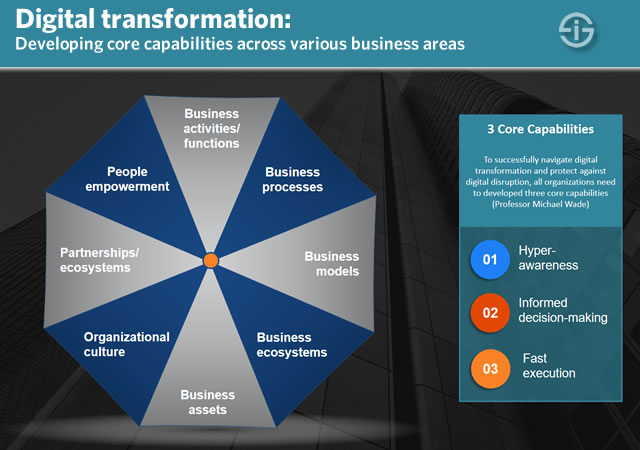
Digital transformation covers a huge number of processes, interactions, transactions, technological evolutions, changes, internal and external factors, industries, stakeholders and so forth. So, when reading advice on digital transformation or reading reports and predictions it’s essential to keep this in mind. Although there are common challenges, goals and traits in organizations across the globe, there are also enormous differences per industry, region and organization. What could make sense in one region, doesn’t have to make sense in another, even if we just look at regulatory environments.
This guide is about mainly about digital business transformation. In other words: about transformation in a context of digital business where there is a decentralizing shift of focus towards the edges of the enterprise ecosystem. The customer in the broadest sense (external and internal with the borders between both blurring) is a key dimension in this equation with customer experience, worker satisfaction, stakeholder value/outcomes, partnerships and a clear customer-centric approach as components.
Technological evolutions and technologies, ranging from cloud computing, big data, advanced analytics, artificial intelligence, machine learning and mobile/mobility (a key game changer) to the Internet of Things and more recent emerging technological realities are 1) enablers of digital transformation and/or, 2) causes of digital transformation needs (among others as they impact behavior of consumers or reshape entire industries, as in the digital transformation of manufacturing), and/or 3) accelerators of innovation and transformation. Yet, technology is only part of the equation as digital transformation is by definition holistic.
DX and hyper-connectedness: focus on the edges
Customer and customer experience, purpose and end goals, partners, stakeholders, the last mile of processes and disruption often sit and occur at these edges and are key for digital transformation. Sometimes digital transformation is even narrowed down to customer experience alone but, strictly speaking, this a mistake, leaving out several other aspects.
The end goals of the business, customers and stakeholders, however, do drive the agenda. The central role of the organization is to connect the dots and overcome internal silos in all areas in order to reach these different goals as interconnection is the norm. In other words: although the focus shift towards the edges, the central capabilities are realized in order to work faster and better for and at the edges. This happens for instance at organizational (integrated, ecosystems), technological (an ‘as-a-service approach’, cloud and agility enablers) and at a a cultural level.
The movement towards the edges also reflects in technologies and computing paradigms such as edge computing and the decentralization of work and business models.
Think about how significant data management and analysis capacity is moving to the edge in a datasphere where real-time demands increase while cloud computing grows in the core, the decentralization of information management, the shifts in security towards the endpoints and much more.
Still, it does not mean that strategic decisions move to the edges or that digital transformation is only possibly in organizations with “new” organizational models. Enterprise-wide digital transformation requires leadership, regardless of how it is organized and as long as the holistic approach towards the goals with the edges in mind prevails over internal silos and de facto gaps between reality and perception. In practice we see that pilot projects on the way to a more holistic and enterprise-wide approach often happen bottom-up, ad hoc or in specific departments. This is normal, typical in early stages but, if not followed through on a broader level, a potential risk for long-term success.
From the same holistic imperative it’s also essential to note that with digital transformation security truly requires a holistic view and even a cyber resilience strategy as data sits everywhere, attacks increase and technological environments become more complex with ever-growing attack surface challenges, third-party risks and software supply chain attacks.
Since digital transformation is an ecosystem play it’s obvious that organizations connect with more (types of) partners, from vendors and suppliers to ample digital business partners. The rise of third parties we connect with also comes with greater risks, hence the growing importance of TPRM or third-party risk management in ever more areas, even beyond the security context.
Digital transformation as a strategy is rarely an end in itself, but rather, a way to meet other strategic objectives – business growth and innovation; a more agile operating model; a great customer experience; and connected and collaborative employees (Bas Burger)
Digital transformation areas
Digital transformation in the integrated and connected sense which it requires can, among, others, touch upon the transformation of:
- Business activities/functions: marketing, operations, human resources, administration, customer service, etc.
- Business processes: one or more connected operations, activities and sets to achieve a specific business goal, whereby business process management, business process optimization and business process automation come into the picture (with new technologies such as robotic process automation). Business process optimization is essential in digital transformation strategies and in most industries and cases is a mix of customer-facing goals and internal goals today.
- Business models: how businesses function, from the go-to-market approach and value proposition to the ways it seeks to make money and effectively transforms its core business, tapping into novel revenue sources and approaches, sometimes even dropping the traditional core business after a while.
- Business ecosystems: the networks of partners and stakeholders, as well as contextual factors affecting the business such as regulatory or economic priorities and evolutions. New ecosystems are built between companies with various background upon the fabric of digital transformation, information, whereby data and actionable intelligence become innovation assets.
- Business asset management: whereby the focus lies on traditional assets but, increasingly, on less ‘tangible’ assets such as information and customers (enhancing customer experience is a leading goal of many digital transformation “projects” and information is the lifeblood of business, technological evolutions and of any human relationship). Both customers and information need to be treated as real assets in all perspectives.
- Organizational culture, whereby there must be a clear customer-centric, agile and hyper-aware goal which is achieved by acquiring core competencies across the board in areas such as digital maturity, leadership, knowledge worker silos and so forth that enables to be more future-proof. Culture also overlaps with processes, business activities, collaboration and the IT-side of digital transformation. In order to bring applications faster to market changes are required. That’s the essence of DevOps: development and operations. In order to make IT and OT work together in businesses/processes/activities, change is required too (it’s not just the information and operational technologies, it’s the processes, culture, collaboration). Etc.
- Ecosystem and partnership models, with among others a rise of co-opetive, collaborative, co-creating and, last but not lost, entirely new business ecosystem approaches, leading to new business models and revenue sources. Ecosystems will be key in the as-a-service-economy and in achieving digital transformation success.
- Customer, worker and partner approaches. Digital transformation puts people and strategy before technology. The changing behavior, expectations and needs of any stakeholder are crucial. This is expressed in many change subprojects whereby customer-centricity, user experience, worker empowerment, new workplace models, changing channel partner dynamics etc. (can) all come in the picture. It’s important to note that digital technologies never are the sole answer to tackle any of these human aspects, from worker satisfaction to customer experience enhancement. People involve, respect and empower other people in the first place, technology is an additional enabler and part of the equation of choice and fundamental needs.
This list is not exhaustive and de facto the several mentioned aspects are connected and overlap. We do look at some less business-related ‘digital transformation’ phenomena and at so-called disruptions but the focus is on the business, which by definition means a holistic digital transformation view whereby aspects such as customer experience, technological evolutions and innovation with a clear purpose, instead of a buzzword, are crucial elements.
So, digital transformation is certainly not just about disruption or technology alone. It is even not just about transforming for a digital age. If it were the latter, one has to realize that this digital age exists since quite some time and is relatively vague.
Digital disruption – what is disruption anyway?
On top of being one of the most hyped terms of the last few years (as is digital transformation as such), digital disruption is mainly used in the sense that an industry, way of doing business or ecosystem (e.g. societal) is significantly challenged by existing (mostly tech) companies, newcomers or incumbents who have mastered digital business skillsets and came up with solutions, business models and approaches that cause a significant shift in customer behavior and market context, requiring existing players (which can include ‘digital businesses’) to change their strategies as well.
Disruption in the end is a shift in power in relationships (Charlene Li)
However, disruption is certainly not only about those initiatives by newcomers or incumbents with disruptive approaches. Disruption in the end is about people, customers.
Or as Charlene Li puts it: disruption in the end is a shift in power in relationships. Disruption, as a human phenomenon, is caused by shifts in, among others, the way people use technologies and about changes in their behavior and expectations. These changes can be induced by new technologies and how they are adopted or leveraged by disruptive newcomers. However, the change can also have a broader context that has nothing to do with technologies. Is that still ‘digital disruption’? No. Yet, in some cases digital technologies could be leveraged to address those changes in behavior or expectations/needs and so forth.
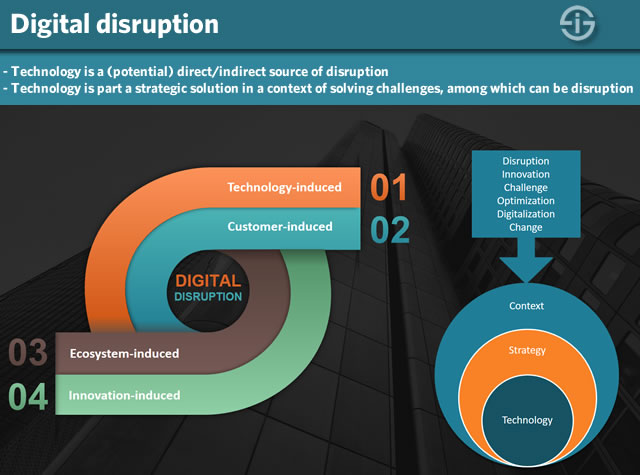
As Sameer Patel points out, disruption often happens in the last mile of customer experience. We would say that, in general, disruption often happens at the various edges of the business; those same edges we just mentioned: the last mile, the customer, the broader ecosystem, etc. In the scope of the broader ecosystem it’s essential to look at the disruptive effect changing economic realities and regulations, for example, can have, again emphasizing the need to put digital transformation advice in perspective.
The fact that digital transformation often focuses on the edges as we mentioned seems obvious when you look at the disruptions and growing expectations at the edges (customer expectations, the knowledge worker at the end of a business process, etc.) who then drive digital transformation.
We always say that technologies are never disruptive. But, to be honest, it’s a bit to challenge people.
We prefer to say that it’s the ways that technologies are adopted and leveraged which can be disruptive, as mentioned. However, obviously, if we drop that tiny remark that as such technologies are not disruptive, it’s clear that some technologies have led to more disruption than others. We’ve mentioned some. Social was a big game changer. Mobile, which leads to the capacity of ‘being mobile’ for sure is one too. Cloud. Big data analytics. In fact, all so-called third platform technologies and their accelerators, with a key role for information and artificial intelligence.
In recent years the evolution towards an Internet of Services and, yes, an Internet of Transformation what the Internet of Things or IoT in the end will be, started playing a crucial role in digital transformation.
Who owns the audience, owns the last mile. Closest to customer, closest to disruption (Sameer Patel)
The Internet of Things or IoT, whereby we move to the next stage of the Internet is still in its early days however. As such, the essence of the Internet of Things as yet another umbrella term for the connection of devices with embedded or attached connectivity and data sensing, sending, analysis and/or reception possibilities using Internet technology is meaningless. Yet, at the same time it will be the glue for a majority of transformational evolutions. In consumer applications the Internet of Things so far has offered little tangible value or true innovation. The main value is seen in the Industrial Internet of Things, whereby industrial markets such as manufacturing and logistics are becoming leaders in transformation. The latter is also due to technologies which are starting to show the tip of their disruptive potential, including additive manufacturing and advanced robotics with AI.
Is there a stage after that? There sure is. For now, we’re going fully hybrid in all senses, also in the integration of digital technologies within our human selves, what the 4th platform will be. Scary for many and not for the next few years for sure. But we’ll get there.
If you ask us what the biggest disruptive technologies will be next (keeping into account that detail we mentioned): it’s the Internet of Things, along with cognitive/AI, Big Data and systems of intelligence. In the meantime the hybrid stage is already here, for instance in an industrial context where the cyber-physical system and, thus again, (industrial) IoT is a key component of Industry 4.0 and the Industrial Internet. Yet at all times the human value and element remains key.
Digital transformation involves managing the existing business and building for the future at the same time, something like changing the engine of the plane while in flight (Ashutosh Bisht, IDC)
Causes of disruption and transformation
“Disruptions” and digital (business) transformation can be caused by numerous factors:
- Technological innovations (technology-induced), which are more impactful than ever before. However, again, it’s not the technology that drives the disruption or transformation. It’s how it is used and adopted by customers, partners, competitors and various stakeholders. Technologies with clear disruption potential include IoT technologies, artificial intelligence, edge computing, virtual and augmented reality and blockchain. However, the most disruptive potential occurs when they get combined and enable new applications as we see in the convergence of AI, IoT and big data analytics. In industrial transformation the convergence of IT and OT is also a game changer.
- Innovation- and invention-induced. Entirely novel approaches to human and business challenges, as well as innovations and inventions that create a new reality, whether it’s in science, business, technology or even a non-technological context of true innovation can be disruptive. The invention of medicines that change healthcare and society (as has happened several times in the past), the printing press, the train, what can be next? Your best bet is probably in life sciences and the application of technology within the human body and mind.
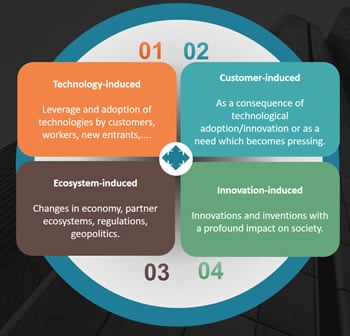
And this ecosystem aspect brings us again to this essential aspect of digital transformation: the interdependency and interconnectedness of everything – and according need to think holistically, across industries and with present and future shifts in mind as mentioned before.
Everything overlaps and is connected; from disruption, business processes and models to business activities and each single activity of the organization and the broader ecosystem in which it operates. It’s the butterfly effect in action. Think about how virtually all business processes de facto are linked, the interconnectedness of business activities from the customer perspective, the way information runs across all digital transformations, the impact events can have on an economy, and much more. Scenario planning is important here.
Why a holistic DX view matters
So, while we just split up some aspects of digital (business) transformation, it’s of the utmost importance to get that holistic picture.
Businesses have always been changing and innovating, technologies always came with challenges and opportunities, regulations and ecosystems have always evolved. That’s nothing new.
It’s in the degree of interconnectedness and of various accelerations, which require profound enterprise-wide change, that digital (business) transformation is to be seen as more than a buzzword but as a challenge, force and most of all opportunity for organizations that will enable them to achieve the core business competencies they need to succeed in rapidly changing environments where speed of change touches upon a myriad of phenomena, ranging from the acceleration of technological innovation and disruptions challenging the status quo of common business models to the need for speed in dealing with changing customer and partner demand or unexpected events.
Speaking the same language
To make sure we speak the same language it’s important to emphasize that digital transformation is not just about:
- Digital marketing, even if that’s an important part of the business activities and if it’s the context in which digital transformation is often used.
- Digital customer behavior, although it plays a role and customers are increasingly ‘digital and mobile’.
- The transformation of paper into digital information as originally meant nor the digitization of information (flows) and business processes, which is simply a condition sine quod non.
Finally, the reason why we would prefer to speak about accelerated business transformation or, if needed, digital business transformation, is that it’s just a matter of time before no one makes a distinction between digital and physical or offline and online. Customers, for instance, don’t think in these terms at all, nor in the terms of channels.
DX and the usual suspects – beware of hype
Digital transformation is not just about technology but certainly also not just about companies in technological industries or the tech startup scene. This is an often made mistake that can be partially explained because such “usual suspects” (Uber is probably the most mentioned – and most controversial – example) indeed are “disruptively” using digital technologies to alter existing models and markets and – at least as important – get a lot of attention.
However, it’s a mistake to just look at all these tech companies out there that we keep showing as examples of digital transformation. While some have indeed been ‘disruptive’ in the sense of forcing bigger players to adapt or die and we can learn from these start-ups and the technology success stories everyone talks about, it’s easy to overestimate them, certainly when comparing with the organizations that have been successful at digital transformation in ‘less sexy’ but sometimes far more challenging and interesting areas.
The attention given by media and tech fans to disruptors such as Uber and the other usual suspects is not without danger and hype. Digital transformation leaders can be found in virtually all industries and often are not among these darlings of those fascinated by digital technologies and companies as such. Digital transformation is industry-agnostic and starts with the business goals, challenges, customers and context of the organization.
Incumbents are transforming too, albeit not all and at different speeds, and in several industries such as finance, there are transforming partnerships between incumbents and ‘disruptive’ newcomers. Last but not least, these so-called disruptive companies can be and will be disrupted as well, by any potential evolution. Their success is not guaranteed on a longer term and digital pure players sooner or later meet the human need for human interaction as well.
Digital transformation happens everywhere
So, digital transformation hits each industry. But it can also affect all activities, divisions, functions and processes of the organization as it can impact the very business model as such.
CapGemini Consulting was one of the first to come up with the concept of digital transformation and a digital transformation framework as you can see below. The company did so in collaboration with the ‘MIT Center for Digital Business‘ during a three-year study which defined an effective digital transformation program as one that looked at the what and the how.
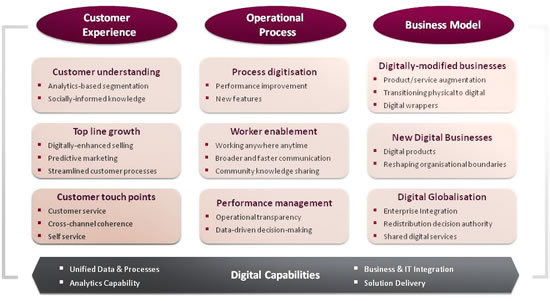
The McKinsey chart below shows just aspects where digital transformation can play:
- The (digital) customer experience (as said, de facto a key element with many digital transformations being a mix of customer experience optimization and process improvement – and cost savings).
- Product and service innovation where, for instance, co-creation models can be used.
- Distribution, marketing and sales: another usual suspect and in practice an area (along with customer service) that is often one of the earliest areas undergoing digital transformations.
- Digital fulfillment, risk optimization, enhanced corporate control, etc.
Others we can add include:
- Intelligent information management (with information, data and the processes they feed being key and a focus on activation).
- Customer service, customer experience management and contact centers, customer relationship management.
- Learning and education.
- Procurement, supply chain management (with the digital supply chain) and supplier relationships.
- Etc.
It’s important to remind that in a digital transformation (and, for that matter digital business) context, all these aspects, functions, processes, etc. are interconnected and silos have less (or no) place, not from a technological perspective but most of all also not from a process and people perspective.
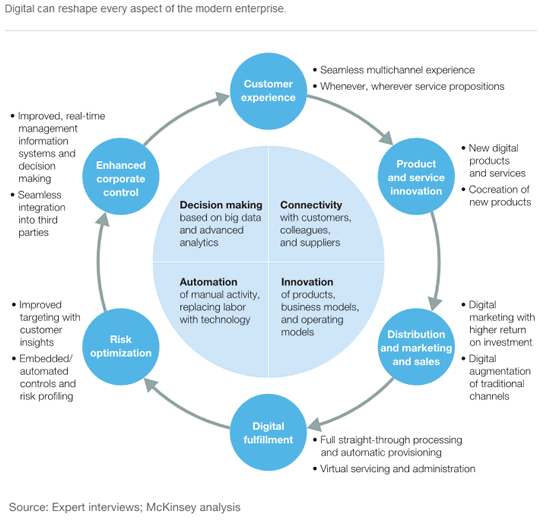
Transformation myths and realities
Digital transformation is on the radar of many organizations. In order to reap similar benefits, it’s important to focus on real business and customer challenges, have a clear – often staged – approach, prioritize and involve all stakeholders in any digital transformation process.
The graphic below from Capgemini (check out the eBook from Capgemini: “The Digital Advantage:How digital leaders outperform their peers in every industry“), dispels some myths and offers some realities.
Four digital transformation realities we want to emphasize:
- Business/IT relationship is key (closing the gap between both, focusing on the same goals and NOT overlooking the role of IT).
- There is a common DNA among digital leaders and the path to digital transformation shows common traits (even if context matters).
- As said, each industry is impacted, including your industry. Customers, employees, partners, nor competitors or new, disruptive players, will wait for business to catch up, regardless of industry.
- Digital transformation is led from the top (or at least requires firm buy-in from the top – and all stakeholders if it wants to succeed in an enterprise-wide way, de facto it also happens from the bottom up and from within specific projects). Often it’s the CEO, the Chief Digital Officer or the CIO but, depending on whom you ask the CMO also gets mentioned now and then.
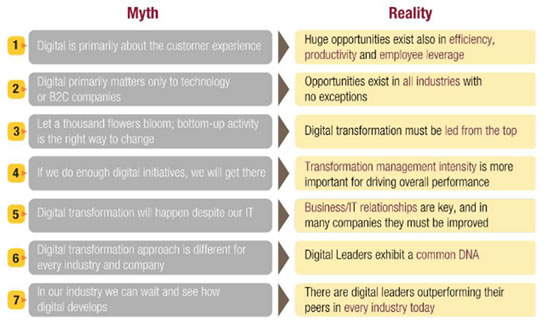
Towards a DX economy
With strong roots in the accelerating adoption of 3rd Platform technology and the transformative effects of this adoption by organizations, workers, consumers or let’s say people, the role of digital transformation is evolving.
With a clear focus on (digital) customer experience and overall stakeholder experience, while optimizing costs, innovating and creating competitive differentiation, digital transformation is set to become the cornerstone of a digital transformation or DX economy in the words of IDC.
Adding more technologies to the 3rd Platform and, more importantly, witnessing an added layer to the core technologies and innovation accelerators of innovation and transformation, IDC sees a future whereby this layer where the optimization, transformation and innovation as such accelerates.
And this, in turn, will lead to a DX economy. But make no mistake about it: despite all the technology it’s still about (digital) customer experience and stakeholder experiences or the human dimension, empowered by processes, information and the 3rd Platform evolutions in the first place. Again, digital business transformation is not just a technology or IT matter.
Moving from transformational technology to transformation economy in 5 stages
Taking into account the just mentioned caveat about technology and IT, of course there is a clear link with digital technologies. So let’s take a look at the evolution towards this so-called digital transformation economy.
Stage 1: the 3rd Platform and digital business
In 2007 IDC introduced the 3rd Platform, back then consisting of four technological/business pillars: cloud, big data/analytics, social (business) and mobility.
Gartner called it the ‘Nexus of Forces’ and, as others did, talked about SMAC (social, mobile, analytics and cloud). Regardless of the name: what mattered was that these technologies and, more importantly, their adoption by consumers, workers and businesses, their behavior-changing impact and the ways they were leveraged to achieve various goals were dramatically altering the business reality – a digital business reality.
Stage 2: the innovation accelerators of the third platform
The 3rd Platform, which is preceded by respectively the mainframe and client-server model era/platform, was joined by various other technologies which IDC called innovation accelerators.
These include robotics, natural interfaces, 3D Printing, the Internet of Things, cognitive systems and next generation security. So, we are still on a predominantly technological level here but with a clearer focus on business and customer innovation (on top of the traditional goals of optimization and so forth).
Stage 3: from digital transformation to innovation stage
What we see now, at least at companies that have deployed initiatives with a clear maturity in various areas and a longer term vision, is that innovation (regarding new business models, ways of engaging customers, building ecosystems of new revenue etc.) becomes key as the foundations, goals, strategy, culture and vision to do so are in place.
With the digital customer experience, innovation, competition, differentiation, automation, cost reduction, optimization, speed and experiences of stakeholders as business drivers, the mentioned technologies and the way they are used lead to that famous next wave or additional layer of innovation and of digital transformation. This in turn, IDC says, led to an innovation stage and information is essential to enable it. Digital transformation requires IT and information excellence in an end-to-end approach.
Stage 4: the acceleration of innovation and transformation
This stage of innovation and further challenges brought by disruptive business models will accelerate in the next years.
In other words: what we (will) see is that the pace of innovation and transformation is changing and resulting in a stage whereby the disruptive impact of digital transformation is about to be felt in every industry as enterprises flip the switch and massively scale up their digital transformation initiatives as IDC’s Frank Gens put it, to secure a leadership role in the ‘digital industrial revolution’.
Stage 5: DX at the core of a new economy
Finally, it’s this ‘digital industrial revolution’, which IDC dubbed the digital transformation economy or DX economy, that will put digital transformation at the center of growth and innovation strategies.
They will rapidly impact all industries even more and faster than we’ve seen before. And the innovation accelerators such as the Internet of Things, cognitive (artificial intelligence) and the likes will be key in this evolution, as are the ‘traditional’ backbones of the 3rd Platform (cloud, big data/analytics, mobile etc.)
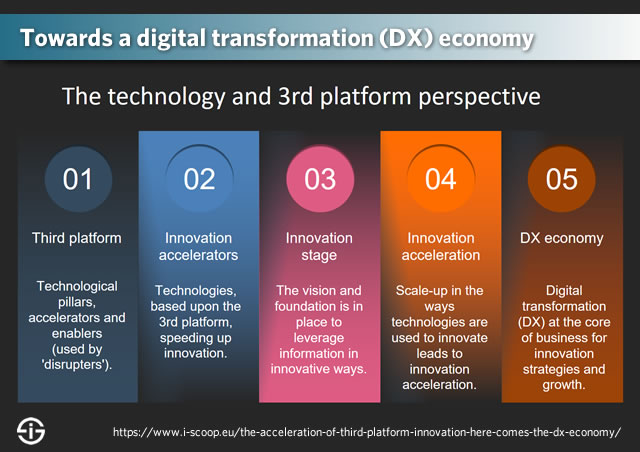
The digital transformation economy: DX moves to the core of business
Digital – and technologies in general – always had a deep impact on business and society. As mentioned, one of the changes that we see in recent years is the speed at which it’s all happening. The technological evolutions and changes they bring upon us are accelerating fast, displaying exponential growth – and consequences.
This speed is contextual and felt differently across various industries. It goes hand in hand with the role ‘new technologies’ can play in the specific industry, the market conditions, the types of customers and stakeholders (and go-to-market approach) and so much more. Still, speed is crucial in more than one way. There can always be an organization in any industry that sees and grasps the opportunities competitors don’t. And in some parts and functions of the business a lack of speed just isn’t an option, regardless of industry.
Finally, exponential growth or speed of change in any area whatsoever (customer behavior, regulatory frameworks, technologies etc.) can happen at the most unexpected moments.
Creating the conditions to be ready for rapid evolutions and ideally pro-dapt and take the lead, changing the status quo, is part of business transformation.
Acceleration of innovation and transformation
While a range of technologies have accelerated disruption, business innovation and changes in human behavior, the exponential growth and pace of change is just a fraction of what is yet to come.
Although digital business transformation is not about digital technologies as such, it is clear that the adoption and opportunities of technologies under the umbrellas of social business, cloud, mobility, Big Data (analytics), cognitive computing and the Internet of Things and more will always speed up changes across society.
However, the real acceleration happens when the acceleration of innovation and transformation as such goes exponential. And that is what analysts mean when they talk about the digital transformation economy or DX economy: not just acceleration of disruption and changes but acceleration of the actual digital transformations and innovations leading organizations will go through, making the gap with laggards even bigger.
Pro-sponsiveness and pro-daptation: focus on future and outcomes
Beyond a dimension of responsiveness/agility (and adaptation and often catching up with customers and ecosystems that change faster than organizations can) in a rapidly evolving context (remember: not linear but exponential), which de facto requires a higher degree of agility and connectedness, there is also a “pro-sponsive” element.
A dimension of being the disrupter instead of disrupted. Of forward-thinking change, anticipation, innovation and simply thinking and working out of the box of the usual, the past and the present. The outcomes of such “pro-sponsive” approaches are what matters most, which brings us to the next point.
To achieve them, however, many conditions need to be fulfilled in an often staged approach and always involving people, processes and technologies. Again three usual suspects indeed.
Digital transformation, digitization and essential elements
Historically, digital transformation was also used in another sense: namely the digitization of paper into digital formats into processes.
These digitization dimensions of turning paper into digital information into processes in a more ad hoc way are obviously necessary in digital transformation in the broad sense.
Digital transformation projects requires several elements to succeed and digitization is a part of it. Among the many elements, we mention four that are related with technology, people and/or processes.
Change management.
As it is the case in virtually all impactful changes that affect multiple stakeholders, divisions, processes and technologies (including implementing an enterprise-wide marketing ROI approach, a content marketing strategy or any integrated marketing approach with CRM, marketing automation, etc. to mention three marketing-related ones), there is not only an opportunity for change and looking at what can be done better and what should be (re)connected but also a need for change management.
Knowing the role of data and analytics in digital transformation, there are even more opportunities for change and needs for change management. This is not new: when web analytics became popular, for instance, their implementation and the connection between different data and analytics “silos” in the customer/marketing space, often showed clear needs for digital transformation in many customer-facing and customer-oriented operations, long before the term digital transformation became known. Grasp those opportunities and tackle the challenges. People and processes.
If things change too fast for people or we are not taking into account the individuals that are touched, as well as their concerns, this can be a recipe for failure and at broader scale even resistance.
However, change management first and foremost obviously is about the human dimension: internal customers, stakeholders, the broader ecosystem within which organizations reside. No organization, business, governent or NGO, can realize a profound digital transformation without putting people first and having people on board. If things change too fast for people or we are not taking into account the individuals that are touched, as well as their concerns, this can be a recipe for failure and at broader scale even resistance.
Intent and priorities.
The world is full of roadmaps for virtually any digital transformation project. However, roadmaps are what they are and the intent, priorities, pain points and actual needs for the individual business and the people in its ecosystem, within a broader reality, matters more.
There is never a one size fits all solution and intent, outcomes and priorities steer the digital transformation efforts, on top of changing parameters in the ecosystem. Priorities also means prioritization, often including looking at the low hanging fruit but always with the next steps and ultimate goals in mind, knowing these goals – and the context within which they were set – will evolve.
Digitization
We mentioned it before but it’s important. It’s a mistake to think that organizations are really ready for profound digital transformation in a broad way.
There are still far too many gaps in regards to the digitization (and automation) of existing processes and the digitization of data from paper carriers. Worse: what is sometimes called digital transformation is sometimes “just” digitization (turning paper into electronic information into processes). You need digitization in order to optimize in a digital transformation context but digitization does not equal digital transformation. What matters is the combination, strategic and prioritized interconnecting and the actions you take to achieve business goals through digitization and combining data.
Furthermore, there is an even bigger gap between back-office processes and the front end. An example of this phenomenon can be seen in the financial industry, where there are extremely strong disconnects between the back-office and front end. There are lots and lots of digitization efforts that still need to be done in many areas of business and society and we all know and feel it, whether it’s in our daily experiences as “business people” or in the often totally unnecessary administrative tasks in regards to our governement-related or finance-related ‘duties’ and interactions with business where we’re forced to use paper, the phone or channels we really don’t want to use anymore.
Silos, responsibility and skills
Digital transformation – just as social business, digital business and any form of customer-centric marketing and business processes, requires the ability to work across silos. In many cases, digital transformation even is about totally reworking organizational structures, which can be as much about collaborative methods, Centers of Excellence as removing specific silos.
The debate about the responsibility over digital transformation as a whole and within specific functions and processes in that sense of genuine transformation is archaic, even if it needs to be held as Chief Digital Officers, CIOs and other CxOs all play a role. Here again, there is no ideal solution regarding responsibility: context does matter.
Marketing should learn from IT and IT from marketing. Sales from customer service, the contact center from sales, the list goes on. A digital-savvy culture is not the goal of digital transformation but today’s CxO needs to be not only digital-savvy but also know 1) what others are doing and 2) their experiences, methods and skillsets. As for the responsibility debates: here as well, multiple options exist as there is ‘no one size fits all’.
Getting strategic
Enterprise-wide digital transformation in the true sense as we defined it previously, requires a strategic approach.
Knowing the many components, technologies, processes, people, goals and integrations that are required, it seems virtually impossible to design a digital transformation strategy. Yet, it isn’t.
Getting the right answers requires the right questions
It’s probably one of the reasons why there are so many digital transformation maturity models and generic frameworks.
Still, as each business is different how do you start with a digital transformation strategy that works for your future, your goals, your potential disruptions, your workers, your market and your customers?
Complex challenges and complex questions can rarely be answered by easy answers and frameworks. However, in practice we see that easy answers are also lacking because easy questions are not asked to begin with.
It is a recurring theme we see in many areas of business and technology. In digital transformation, in Internet of Things projects, in marketing, you name it: when technology is involved we seem to forget the basics.
Digital maturity benchmarks and DX strategy
Digital maturity frameworks and benchmarks do have value. They indicate that digital transformation is a journey towards acquiring a set of capabilities and changing a range of processes, functions, models and more with the purpose to (be able to) leverage the changes and opportunities of digital technologies and their impact across society in a strategic and prioritized way, as we defined digital transformation earlier.
This comes with several consequences:
Digital transformation is not just about a specific project, process or optimization exercise. It’s a holistic given and it doesn’t happen overnight. There are many components and intermediate goals. It happens in incremental steps, hence the digital maturity views.
The various stages, steps, projects and so on in the context of digital transformation have one or more goals as such, yet at the same time fit within the broader purpose which we just established by referring to (part of) our definition. In other words: you have a roadmap and an end goal in mind.
Although it might sound like a contradictio in terminis, the end goal of digital transformation changes, making it a journey. New technologies will offer new opportunities and challenges, as will changing market conditions, competitive landscapes and so forth. While digital transformation has a goal of preparing us for those, at the same time that goal as such is subject to change.
Change is a constant. From a digital transformation strategy perspective this means that uncertainties, risks and changes are factored into each incremental step and the broader objectives but it also means that a digital transformation strategy comes with agile possibilities to change course, thanks to intermediate checks and balances and a ‘hyperaware’ ability of continuous improvement or change (both are not the same).
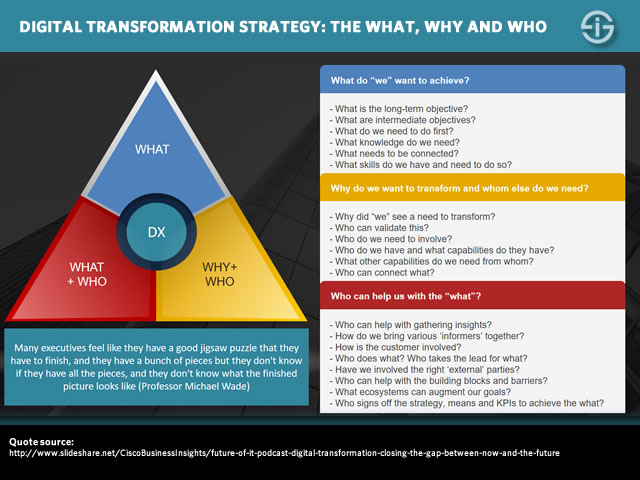
The first step of a digital transformation strategy
Those previously mentioned basics are about the first steps in defining and deploying a digital transformation strategy. And, as always they are about the what, why and how.
Yet, we need to make a distinction here. As you know people look at digital transformation in various ways.
- Some see it as one or more projects in the context of digitization (which it is not) and of digitalization (which it can be). In these cases, the what, why and how can be filled in very differently, depending on the nature and scope of the project(s).
- Others, including us, see digital transformation as this all-encompassing transformation as we defined it. In this case the goal (the what, supported by the why) is a digital transformation capacity as such, at the very core of the business, whereby digital transformation becomes the condition and enabler of the capacity to fully leverage changes and opportunities of (digital) technologies and their impact.
However, as mentioned this doesn’t happen overnight and requires a series of incremental steps. And here the goal or ‘the what, why and how’ becomes a mix of intermediate goals and broader objectives within which they gain more significance.
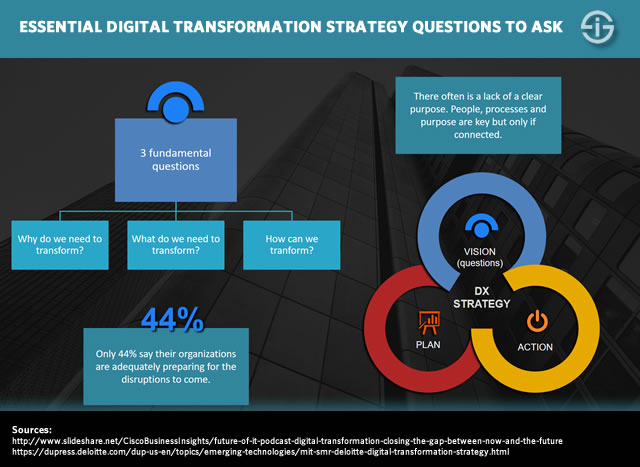
The future: COVID-19, sustainability and the impact of challenges ahead
In 2020, the pace of digital transformation started accelerating due to the COVID-19 pandemic. As organizations and societies as a whole needed to leverage technologies across virtually all aspects of business and even our private lives, we saw several – obvious – areas get more ‘digital’ than before.
We touched some of the COVID-related acceleration aspects during the first wave of the pandemic. Nicolas Windpassinger, author of IoT book ‘Digitize or Die‘ and Global Channel Program & Digital Platforms VP at Schneider Electric, wrote an article with his views on the ‘new normal‘ – with a focus on channel partners.
In it, he looked at some of the areas where change would be more and less lasting, according to him. Examples include
- the sheer fact that many people started using digital channels for specific purposes for the first time (and will often continue to do so because they can),
- the inevitable shift – where possible – to remote work (and hybrid work),
- further digital transformation in sales and marketing,
- a change to ‘remote everything,’ at least where it makes sense,
- etc.
COVID-19, and positively the impact of the measures taken by organizations and government, is omnipresent in the outlooks for global economies and thus also IT, digital transformation, etc.
One of the more critical lasting consequences is that organizations don’t just revise their digital transformation roadmaps and structures but also up their investments in digital experiences, digital ecosystems, and so forth.
Moreover, even if this isn’t just about COVID-19 alone (climate change is becoming more important and, along with it, sustainability, to give only one example), we can expect the maturity of digital transformation initiatives and systems increase.
Simultaneously, it is expected that more and more organizations will have comprehensive digital transformation implementation roadmaps that look at ‘true transformation’ across all facets of business and society.
That’s precisely one of the predictions from IDC’s “IDC FutureScape: Worldwide Digital Transformation 2021 Predictions“, released end of 2020. According to IDC, by 2023, 75 percent of organizations will have comprehensive DX implementation roadmaps, up from 27 percent today. And this, the research firm says, will indeed result in this “true transformation across all facets of business and society.”
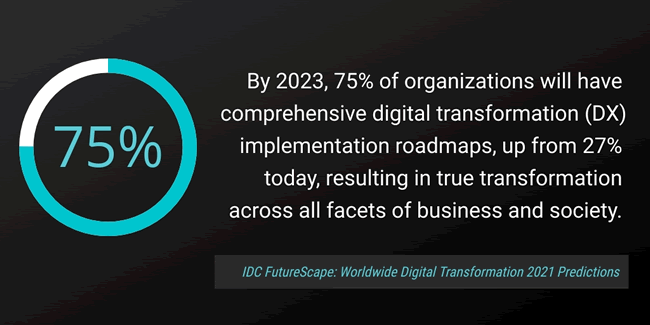
IDC further expects accelerated digital transformation investments with an increasing focus on business model reinvention (future-proofing) and on the combination of digital and sustainability, among many other forecasts.
The future will bring highly unpredictable and subject to geopolitical changes, now perhaps more than ever, and IDC looks at larger organizations. Still, it’s clear that digital transformation has accelerated overall and will continue to do so in several areas indeed.
The importance of a holistic transformation approach instead of just ad-hoc optimization and digitization/digitalization initiatives whereby business model transformation, future-proofing, ecosystems, etc., become more critical this way has become more evident in the past years, further accelerated by COVID-19 and our future challenges.
For many companies, this might be a few steps too far. Still, one might be surprised how also small organizations that are part of the right ecosystems can transform from the edge – and even at the very core where such is often needed as a consequence of, among others, the pandemic (and a shift in thinking), those geopolitical events, climate change, an inevitable few years of economic hardship, etc.
By 2021, at least 30% of organizations will accelerate innovation to support business and operating model reinvention, fast-tracking transformation programs to future-proof their businesses (IDC)
Digital transformation and the customer experience
In most digital transformation projects the customer experience and the user experience (remember both are not the same) take center stage. The customer experience, however, is a catalyst and driver of many digital transformation efforts.
The customer experience doesn’t belong to just one department and a transformational approach by definition includes several stakeholders, including the customers.
While technologies have affected customer behavior and expectations on one hand and enable transformations on the other, the focus is on people and processes. To truly enhance the customer experience in an enterprise-wide and holistic way, several elements, divisions, caveats, processes and technologies need to be taken into account.
However, the people dimension is probably – and obviously – the most crucial of all in the customer and customer experience context. The customer experience is probably also one of the key areas where business meets IT in a transformational perspective.
Digital transformation and marketing
Just as the customer experience is a catalyst in many digital transformation projects, it also has become pivotal in marketing, service and customer-facing processes.
Marketing is one of many areas where digital transformations take place (even leading to confusions whereby digital marketing transformation is used interchangeably with digital transformation).
The digital customer journey, data and data-driven marketing, social CRM, the contact center and – again – the customer experience are important elements in this regard. The digital marketing transformation imperative is driven by changing customer behavior and expectations before anything else. With the end of the sales funnel and ongoing fragmentation in an increasingly digital customer reality whereby control has shifted in mind, marketing has no choice than to transform and to work closer together with other divisions such as IT and customer service, to name just two. This also has consequences for the marketing function and changing role of the CMO.
Last but not least, the need for digital marketing transformation goes hand in hand with the connected optimization goals.
Digital transformation and hyper-connected optimization
Regardless of the technological evolutions and the acceleration and impact of their adoption, a core reason to ‘digitally’ transform is the urgent need to have a very holistic and connected approach towards (customer-centric) optimization.
For all too long optimization efforts, whether it’s in business processes, marketing optimization of customer service level improvement, has occurred in disconnected and siloed ways.
In an increasingly connected and complex customer, worker, partner and other stakeholder environment, this isn’t possible anymore.
Holistic optimization looks at the broader picture of improvement, not just by seeing how everything in an optimization ‘chain’ is de facto connected but by actually setting in motion the necessary transformations and innovations to optimize in a far broader and interconnected way than ever before: beyond functions, divisions, silos and anything making an end-to-end optimization and experience flow impossible.
This focus on optimization through digital transformation is directly linked with the goals of (customer) experience enhancement and stakeholder engagement. It goes hand in hand with process optimization, often automation and cost efficiencies.
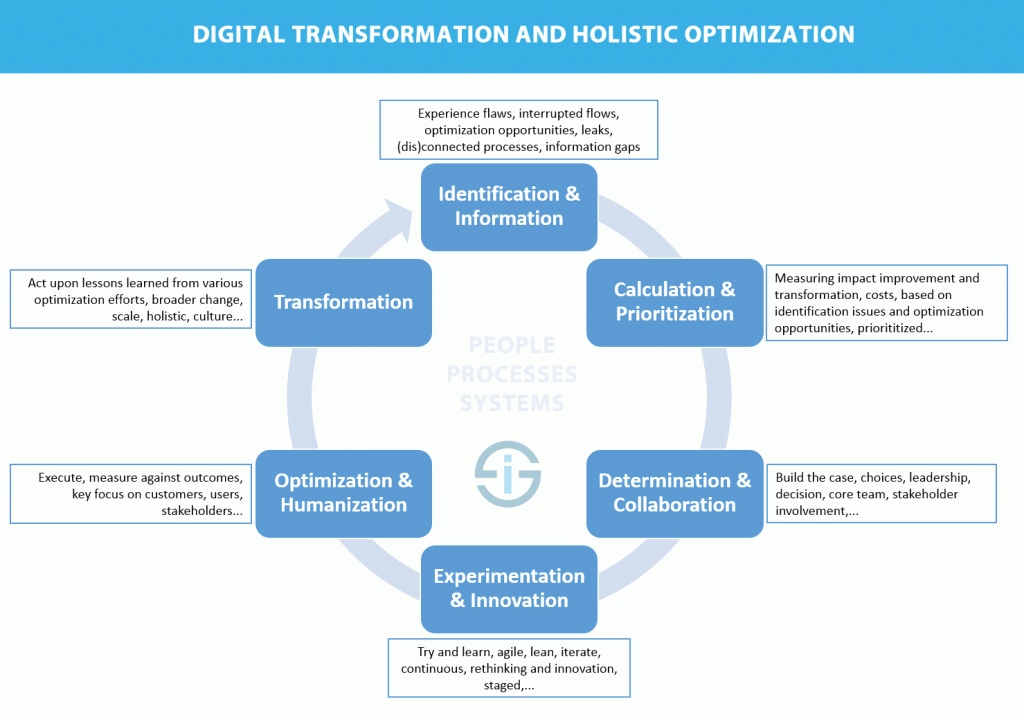
DX and the key role of data and information
Even if information is at the very center of digital transformation, the link between information management and digital transformation is not made often enough. If we look at other elements at the center of digital transformation this is a pity.
After all, whatever the form of optimization, communication, collaboration, interaction, experiences, innovation and so on: information (or content or data) is a key success factor to make it happen (on top of human factors, leadership, processes, organization etc. which also require information).
Information chaos and information as an enabler
There are four so-called information chaos challenges according to John Mancini of AIIM (association of information management professionals):
- How do we optimize business processes?
- How do we get any business insight out of all the information we collect?
- How do we use information to better engage customers, employees and partners (also think omni-experiences)?
- How do we manage the risk of growing volumes and complexity of content?
Turning these ‘information chaos’ problems into solutions is a lot what the link between digital transformation and information management is about.
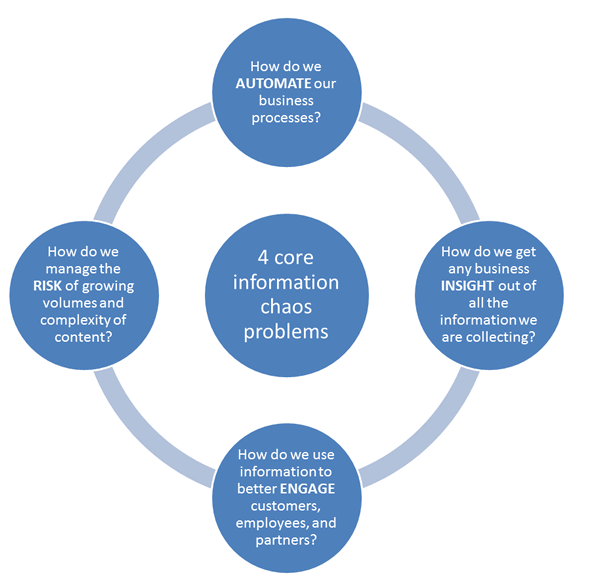
But there is more. Information management plays a role as a digital transformation enabler and in each step towards achieving digital transformation goals such as increased customer-centricity, the enablement of effective knowledge workers and operational excellence.
Information and information management are also key in all three parts of the well-known 1) people, 2) process and 3) technology/tools triangle. To learn more click the link below.
Digital transformation and intelligent information
In a digital transformation context, ‘managing information’ and data is crucial but it’s not enough. In today’s and tomorrow’s information- and data-driven business, insights, intelligence and actions matter most: the outcomes.
That’s where context, semantics, artificial intelligence and activation come in. With the Internet of Things and Web 3.0 upon us the intelligent dimension becomes more important in regards to making sense of unstructured information, automation and connected devices and putting information at work. It’s why we talk about ‘intelligent information activation’.
As we shift towards information-based organizations and information has become part of the capital and business assets of the enterprise, an intelligent information management approach enters the boardroom.
At the same time the activities around and value of data are looked upon from the perspective of engagement, outcomes and the last mile.
Making data actionable, introducing devices (IoT) in an increasingly complex and growing data landscape, the steep growth of unstructured data, deriving meaning and insights from information and leveraging it at the right time and right moment for the right reasons and actions are all critical.
From information management to intelligent infomation activation
This isn’t just about ‘managing’ information in the traditional sense anymore. It’s also not just about connecting systems and data nor even connecting through information. With the advent of the Internet of Things, the need to ensure data quality and the increasing need to use and unlock it faster, despite the sheer volume, adds several elements to the information and transformation equation.
Among them are:
- intelligence (as in artificial intelligence as the only way to add and extract meaning from ever more data and as the only way to use information and data in an IoT and inter-device context),
- speed (with speed being a customer experience and even competitive benefit),
- a holistic security approach (touching upon classic but evolving and powerful tactics such as phishing and malware, such as ransomware, as well as new challenges such as third-party risks and other security issues),
- the need to digitize and capture paper-based data (digital transformation requires digitization and thus scanning) closer to the source, owner and process to go paperless (paper slows down digital transformation),
- and an increasing focus on accuracy, quality and outcomes.
What this all means and how it will evolve? On top of the existence of systems of records and systems of engagement – which are both needed – we are moving to systems of intelligence and intelligent automation and optimization, ecosystems of code, algorithms, cognitive computing (understanding and beyond) and fast/smart data as ways to succeed with digital transformation and, vice versa, information-based challenges as transformational drivers. To learn more click the link below.
Digital business transformation across various industries
Each business is different. Yet, many of the lessons we learn from leading companies show that digital transformation shows very similar aspects across industries. Still, it’s also important to look at your business and of course your industry.
Digital transformation in the retail industry
Retail is one of the most rapidly changing verticals across the world and is often at the forefront of technological advancement to keep pace with the evolving needs of a 24/7 customer base.
That’s the clear digital transformation message from OVUM regarding the changing retail customer. We can’t but agree and would even add that digital transformation is omnipresent in all aspects of the retail industry. From data and information optimization, supply chain digitalization, delivery and back-office processes to the front end where customer expectations are necessitating transformations and enhancements regarding a seamless channel-agnostic customer experience.
Let there be no mistake: the shop is still very important in retail but here as well consumers have come to expect innovative experiences which bridge the physical in-store and digital journey, which doesn’t exist in the eyes of the consumer anyway.
On top of traditional 3rd platform technologies such as the cloud and big data, there is a myriad of additional technologies that is changing the face of retail completely. Analysts see a growing role of the Internet of Things in retail, mainly in digital signage and cross-channel scenarios. Obviously, these use cases are closely related with the mentioned technologies. Also expect a continuously growing presence of information-driven in-store changes that combine several technologies but mainly look at the essential things retail customers want such as empowered employees who have the tools to provide fast and correct information on products. Winning retailers focus on these essential customer expectations and ways to transform how they are offered, in combination with some more ‘futuristic’ looking innovations as we see them pop up in concept stores but of which several will prove not to be valuable enough.
Digital transformation in manufacturing
Under umbrella terms such as Industry 4.0 (a typical European term) or Industrial Internet (the third industrial revolution through the eyes of the Industrial Internet Consortium), the digital transformation of manufacturing is progressing at different speeds with the integration/convergence of IT and OT as key to improve efficiency and speed.
While leaders in manufacturing transform to optimize operations, enhance customer-centricity, tackle risk, innovate, increase revenues and, most of all, tap into entirely new revenue streams with new business models, revolving around information and services, laggards continue to focus on just the optimization aspect.
This is an essential mistake as without a more holistic digital transformation perspective, leading manufacturers are poised to become disrupters.
Still, things are changing and the main challenges to move towards the Industry 4.0 or Industrial Internet approach, are becoming clearer (the difference between the view of a fourth industrial revolution as in Industry 4.0 and a third one as in the Industrial Internet is really just a matter of details).
On top of challenges and opportunities regarding skill gaps, connected supply chains, real-time economy needs and uncertainties, caused by changing macro-economic and geo-political changes, ample challenges/opportunities exist to move beyond the mere optimization dimension and truly transform at the core with the customer and data taking center stage.
The rather slow enterprise-wide digital transformation in manufacturing is compensated by the industry’s leading place in one key transformative aspect of the Industry 4.0 cyber-physical, data-intensive and innovative services systems and technologies stack: the Industrial Internet of Things. Two other important notions in the digital transformation of manufacturing: digital twins and the mentioned cyber-physical systems approach.
The manufacturing industry by far leads in the Internet of Things space and more and more companies leverage the huge opportunities as a result. Except for the laggards or those missing a clear understanding/strategy. To succeed in Industry 4.0, obstacles need to be addressed. An overview of digital transformation chances, challenges and evolutions, with advice on the strategic and human dimension via the button below.
Digital transformation in government and the public sector
The role and structure of national and local governments, government agencies, state-sponsored organizations and public sector institutions differs from country to country.
However, regardless of the ways typical areas where governments are involved such as public healthcare, transport, public infrastructure, policing and defense, citizen services or regulation, are organized, there are many commonalities in the challenges and priorities, not in the least from the digital transformation perspective.
While from the citizen experience perspective the role of digital transformation becomes clear in areas such as e-government and digital identity programs, in many other areas transparency, efficiency and coordination are key in the digitization of processes and project management.
Research shows that a majority of public sector professionals recognize the disruptive impact of digital technologies on government.
- The first driver of digital transformation in government and the public sector is cost savings in a world where populations are aging and a mix of local, national and geo-political shifts necessitate choices and changes, whereby higher cost transparency and cost reductions are key.
- The second driver of digital transformation in government is meeting the demands of a ‘digital’ citizen and enhancing the citizen experience. Citizen demands are evolving because demands of people are evolving, whether it’s in their capacities as workers, consumers or citizens. Improving the citizen experience of an increasingly digital and mobile first citizen whose digital lifestyle doesn’t match with the often paperwork-intensive reality that is still too dominant and causes frustration is a priority.
- In recent years, we also see that – as they push digital agendas – governments sometimes take the lead with initiatives to boost digital transformation in areas where the public and private sector meet and even in private-to-private environments. They then act as enablers, often in a context of data. This is for instance the case in data-sharing initiatives for data-driven transformation and innovation as the example of a regional European government shows (see the interview with Barbara Van Den Haute).
Digital transformation in the utilities industry
Utility firms face tremendous challenges. Yet, they are at the same time active in an industry where digital transformation can lead to tremendous cost savings, new offerings, alternative pricing models, customer experience optimization and even radical new ways of ‘doing business’, engaging with customers and their very business model.
From a technological viewpoint, the Internet of Things, Big Data and everything related to ‘smart’ play a key role. Furthermore, investments and innovations in making customers aware of their consumption and allowing them to control it in unseen ways add to the many possibilities in areas such as ecology/environment and changing supply chains.
More about these evolutions, challenges and ‘digital possibilities’ on our overview page where we tackle the utilities industry.
Digital transformation in the insurance industry
The insurance industry has numerous opportunities to leverage technologies in transformational ways.
Among the typical areas which are often mentioned are telematics, the Internet of Things, the use of predictive analysis (risk) and new business models and pay-as-you-go insurance approaches.
A majority of consumers would, for instance, be willing to have a sensor attached to their car or home if this would result in a reduction in premiums. Yet, just as much as technologies offer tremendous opportunities which are increasingly being embrace by insurers, there are also challenges. The changed expectations of policy holders and younger consumers play a significant role here. Moreover, there is a lot of work in essential business process such as insurance claims management, customer service and meeting changing regulations. On top of that there is the rise of InsurTech and the fact that consumers buy insurances from non-traditional providers, including retailers.
The challenges and opportunities are vast as you can read on our page about digitization and digital transformation in the insurance industry.
Digital transformation in healthcare
The digital transformation of healthcare among others is driven by the aging/growing population challenge, the rise of chronic diseases, increasing costs and the changed expectations and behavior of people whereby digital health plays an increasingly important role.
These changed expectations and behavioral patterns obviously also impact us as patients, one of many reasons why there is an increased focus on patient-centricity. However, let’s certainly also not forget healthcare workers who display changing behavior as well and use digital and mobile platforms too, which leads to an even more information-driven healthcare.
Mobile (‘mobile ability’) has totally changed the face of healthcare whereby increasing productivity and employee satisfaction is another challenge. Doctors, specialists and nurses often have to work in increasingly difficult circumstances amidst budget cuts.
That brings us to the need for efficiency and fast access to healthcare information for all the obvious benefits. Another challenge concerns the funding of healthcare and, hence, also the leverage of digital technologies to not just save costs but also grow revenues. In some countries healthcare tourism, for example, is even a national priority as they evolve towards a more services-oriented economy (look at some GCC countries).
As we move towards a more connected healthcare the Internet of Things becomes a key game changer to tackle many of the mentioned challenges and reinventions of healthcare models.
There are certainly more challenges – and opportunities – for the digital transformation of healthcare and we dive deeper into several ones on our page on digital transformation in healthcare where we also look at forecasts until 2020 and, among others, see an increase of robots who take care of easy tasks in hospitals, the growing role of remote health monitoring and new healthcare models, linked with data on our lifestyle. And of course there is a key role for information and quite some work in the space of the digitization of health records (EHR/EMR).
Digital transformation in banking
Another example of an industry/vertical that faces urgent digital transformation challenges, albeit with contextual differences, is banking.
Digital transformation in retail banking
Although there are several changes, disruptions and digital transformation (challenges) in retail banking some are restricted (or more/less important) to specific geographies given, for instance regulatory, consumer-related, focus-related and even broader societal elements. More about these geographical differences in “Retail banking: the growing importance of direct and digital channels“.
Retail banks are increasingly collaborating with FinTechs as they don’t dispose of the speed, technology, agility, technological (non-legacy) experience and sometimes even customer experience skills and deep customer understanding FinTechs have. In some regios these collaborative efforts are more important than in others but we clearly see a convergence of FinTech and incumbents in many forms and shapes.
These evolutions, as well as the many challenges, opportunities and transformations retail banks face on our overview page.
Digital transformation in regional and ‘smaller’ banks
Of course digital transformation is not just for retail banks, let alone for large banks.
A nice digital banking framework for regional banks and community banks in practice, with a focus on mobile banking and the gradual deployment of an omnichannel banking platform as depicted above, leveraging tools such as mobile, chatbots, digital payments and Fintech technologies can be found in an article by Konstantin Didur in a community banking context, although it shows deployment stages that might be relevant for larger banks too.
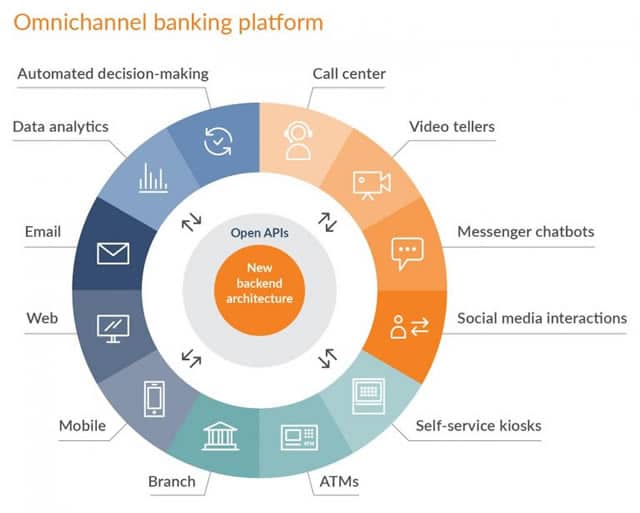
Digital transformation in the supply chain: logistics and transportation
There aren’t many industries with as many interconnected organizations, ecosystems, processes, information flows, devices (from individual goods, boxes and pallets to trucks and ships) and physical distribution and handling operations as transportation and logistics.
In a context of globalization, changing customer expectations, huge pressures on margins, high risks of enormous volumes of data, the logistics and transportation industry is in full flux.
Strictly speaking we of course need to differ between the transportation of people, animals and goods. While the transportation of people of course is being transformed, a large majority of digital transformation budgets goes to supply chain transformation projects with the move from the hybrid model to a full digital supply chain network model of smart supply chain management in smart industry and manufacturing in mind.
In the context of the transportation of goods and the supply chain, speed, visibility, digitization and digital transformation rank high on the agenda.
Given the long-standing usage of sensors and RFID, as well as the need to dispose over data which enable new business models and better processes, the (goods) transportation and logistics industry takes a leading place in the deployment of Internet of Things projects, Internet of Things spending and the Industrial Internet of Things market.
Also data analytics are big in this industry that has been used to work with big data before the term existed. However, among the many transformational challenges is the fact that data maturity levels need to go up and that digital strategies need to be deployed across end-to-end supply chains. It’s a complex given in a highly complex and interconnected industry with many different activities.
Digital transformation and business process outsourcing
There is a thin line between digital transformation and business process management, more specifically business process optimization and reengineering for a digital age and customer.
However, digital transformation also has a profound impact on business process outsourcing (BPO) and thus the industry of BPOs. Business process outsourcing is moving from its traditional predominant cost-saving and (outsourced) process optimization roots to a cost plus optimization plus innovation plus value proposition.
Organizations have changing expectations from their BPO partners, who need to transform themselves, in order to meet these changing demands of disrupted customers.
Business process outsourcers need to be far more aligned with business, acquire new skills, transform and optimize their own operations, and last but not least, seek how to add more value to their propositions.
When organizations transform, then so do their partners to whom they outsource specific business processes.
Digital transformation beyond technology: the human differentiator
To understand digital transformation, it’s key to put people and processes above technology, even if technology is a change agent – or at least the ways we use it to evolve, innovate, adapt and “pro-dapt”.
Digital transformation is about using digital technologies to improve (and connect and often radically change) processes, enhance customer experiences, focus on the area where business and customer value meet and seeing new and better possibilities , while using different and digital-intensive ways to realize them. Digital transformation even goes beyond the use of digital technologies to support or improve processes and existing methods. It is a way to alter and even build new business models, using digital technologies. In that sense, it also goes beyond digitization (although that’s often a condition to make it happen) and certainly beyond a digital-savvy skillset and capacity which is nothing less than a must in the age of an increasingly channel-agnostic and digital customer.
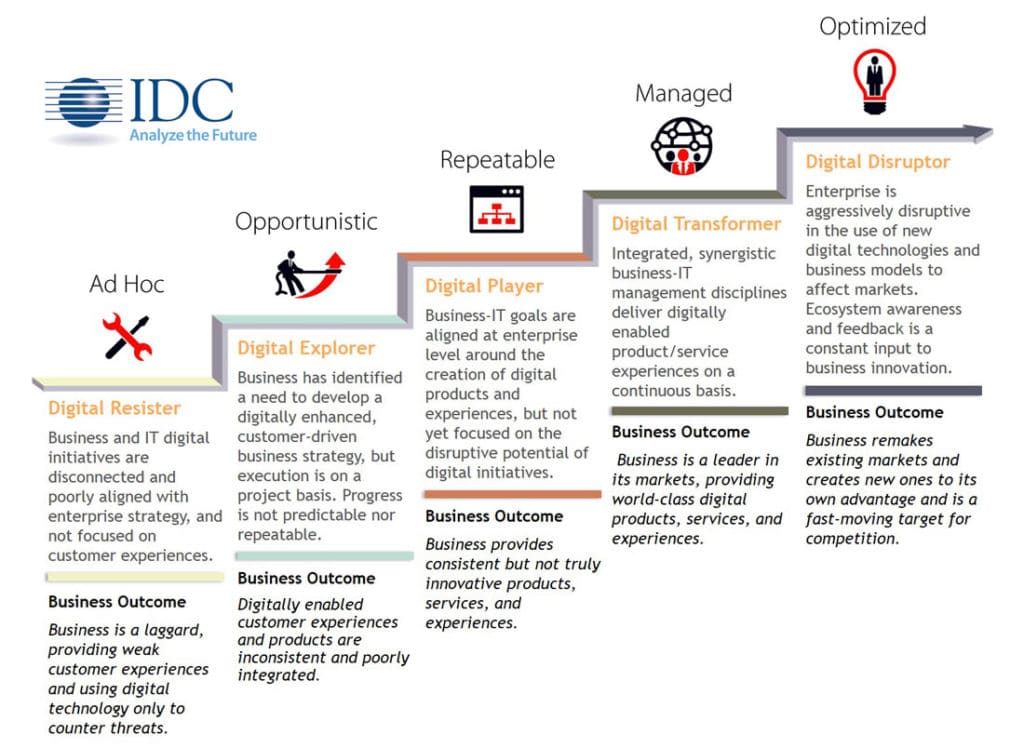
However, this so-called digital culture is not the start or essence of digital transformation. Digital transformation is also about responding to the changes that digital technologies have caused – and will continue to cause – in our daily lives, individual businesses and organizations, industries and various segments of society. These changes are obviously not brought upon us by the technologies themselves. The human dimension is not just an important focus of digital transformation, it’s a catalyst whereby the ways we use and see digital technologies can have very unexpected consequences, regardless of whether it concerns consumer/customer behavior or the innovative capacity of disruptive companies (nearly always a mix), in the end also people.
In the end, the mindset, let alone somewhat vague term ‘culture’, and approach we need is one of continuous optimization, holistic improvement and a focus on what people need, far beyond the digital context.
Digital transformation and linear management thinking
With digital transformation being a de facto very hyper-connected reality on human, societal and various business and technology levels, linear management thinking and siloed approaches make place for hybrid, integrated, inclusive and fluid ecosystem views beyond the classic extended enterprise model.
In practice this means that executives need to have a far better understanding and skillset regarding the various domains which are involved in digital transformation processes.
A CIO needs to understand customer-centricity. A CEO needs to know about the many parts of business process reengineering, cybersecurity, IT and more. The list doesn’t end there. As the drivers of technological innovations also shape the directions in which economies and businesses move (and vice versa) the ability to connect the dots and step away from linear view towards elasticity and hybrid approaches. Understanding the impact of transformations in so many areas is probably one of the main challenges for executives. Welcome to a hybrid and fluid world – for executives too.
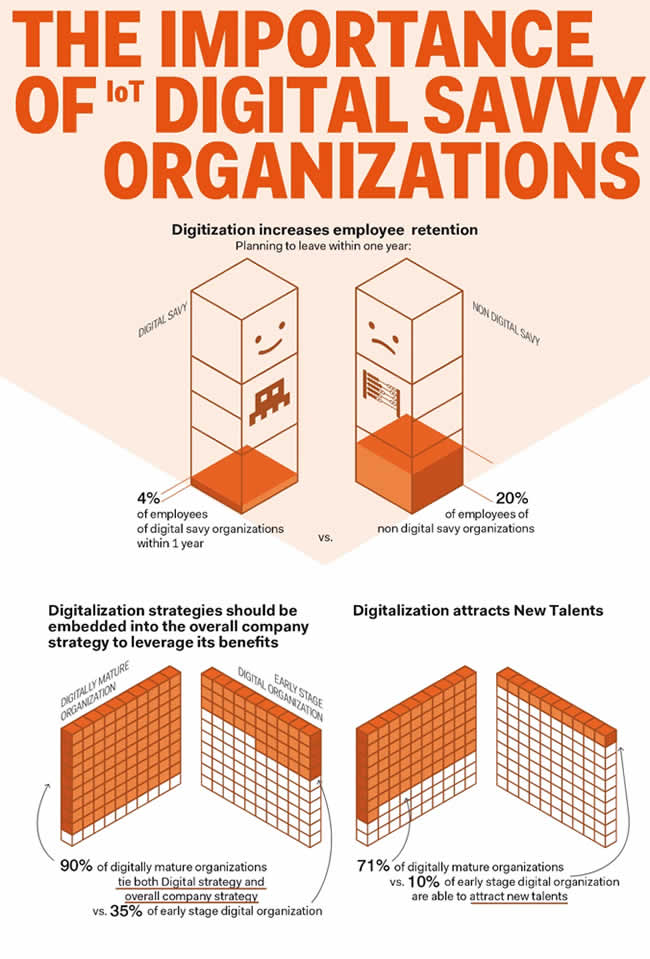
Digital transformation – the inevitable definition discussions
Definitions are important. Without common definitions we don’t know what we talk about when we talk about it. That’s why through the years we wrote a content marketing definition, a social business definition, an Internet of Things definition (always mentioning definitions of others), the list goes on.
One of the many topics we didn’t write a definition for is digital transformation. Ironically, for reasons we ignore, when you look up the term “digital transformation” on Google a part of this page shows up first (that could have changed by the time you read it). It might be the reason why you are here to begin with.
Obviously that part (which you see on Google) is just a piece of what’s written on this page and as you might have noticed we didn’t say ‘this is our definition of digital transformation’. Moreover, if you type in ‘digital transformation definition’, you’ll see Wikipedia, not this page. Since we started writing about digital transformation, many people looked at that Google ‘description’. Some liked it, some thought it was too vague and we were amazed to see what an impact it has. In case you want a definition of digital transformation, well, for us it’s somewhere hidden in this page and not just in the first paragraph.
We decided not to write a formal definition of digital transformation as the term is used by so many for so many reasons and from so many angles that it’s become an umbrella term. Maybe one day we’ll add a list of definitions with or without comments, maybe not.
What matters to us is that digital transformation takes into account all the parameters that are needed to succeed, depending on your strategy, roadmap, goals, stakeholders, context and so forth. What also matters to us is that you don’t look at digital transformation from a pure technology nor a pure marketing or any other angle.
The reason we added this little addition on digital transformation definitions is really because you can’t imagine how many discussions there have been about “our definition” (even if we never wrote one) and how many people absolutely want us to push their definitions.

